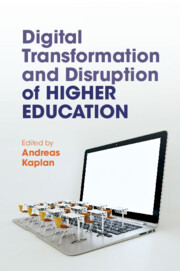Book contents
- Digital Transformation and Disruption of Higher Education
- Digital Transformation and Disruption of Higher Education
- Copyright page
- Contents
- Figures
- Tables
- Contributors
- Preface
- Chapter 1 Nothing Is Constant Except Change
- Part I (R)evolution of the Higher Education Sector
- Part II Changes in Teaching Formats
- Chapter 7 Contemporary Changes in Teaching Formats
- Chapter 8 Digital Transformation in Teaching and Learning
- Chapter 9 Blending Emerging Technologies for Student-Centred Teaching
- Chapter 10 Artificial Intelligence
- Chapter 11 Quality Assurance and Enhancement
- Part III Changes in Teaching Content
- Part IV Networking and Social Activities
- Part V Certification and Diplomas
- Part VI Careers and Professionalisation
- Part VII Futuristic and Ultramodern Higher Education
- Part VIII Higher Education in Motion
- Editor’s Biography
- Index
- References
Chapter 11 - Quality Assurance and Enhancement
An Application of Digitalised Data
from Part II - Changes in Teaching Formats
Published online by Cambridge University Press: 09 June 2022
- Digital Transformation and Disruption of Higher Education
- Digital Transformation and Disruption of Higher Education
- Copyright page
- Contents
- Figures
- Tables
- Contributors
- Preface
- Chapter 1 Nothing Is Constant Except Change
- Part I (R)evolution of the Higher Education Sector
- Part II Changes in Teaching Formats
- Chapter 7 Contemporary Changes in Teaching Formats
- Chapter 8 Digital Transformation in Teaching and Learning
- Chapter 9 Blending Emerging Technologies for Student-Centred Teaching
- Chapter 10 Artificial Intelligence
- Chapter 11 Quality Assurance and Enhancement
- Part III Changes in Teaching Content
- Part IV Networking and Social Activities
- Part V Certification and Diplomas
- Part VI Careers and Professionalisation
- Part VII Futuristic and Ultramodern Higher Education
- Part VIII Higher Education in Motion
- Editor’s Biography
- Index
- References
Summary
Quality assurance and enhancement exercises are important in higher education. Curriculum assurance and enhancement exercise, relied in the past primarily on raw assessment data and self-reported, which lacked follow-up mechanisms gauging its effectiveness. This paper reports on an impact study of a curriculum review exercise using both digitalised data and self-reported data. Both the original review and its impact study were conducted on an English Programme in a Hong Kong university taken by around 6,000 students each year. Both adopted a learning analytics approach with digitalised behavioural and assessment data. Results of the impact study, which is the focus of this paper, demonstrate the strength of using learning analytics, including its capability of inter-course and intra-course investigations. Learning analytics can also empirically confirm and/or refute concerns reported by teachers and students. The use of digitalised data for learning analytics offers opportunities to implement and follow-up on quality assurance measures.
Keywords
- Type
- Chapter
- Information
- Digital Transformation and Disruption of Higher Education , pp. 130 - 144Publisher: Cambridge University PressPrint publication year: 2022



